

Six degrees of separation. Six degrees of separation.
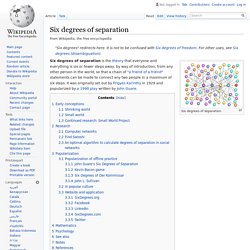
Early conceptions[edit] Shrinking world[edit] Six degrés de séparation. Un article de Wikipédia, l'encyclopédie libre.
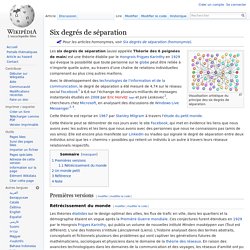
Visualisation artistique du principe des six degrés de séparation. Les six degrés de séparation (aussi appelée Théorie des 6 poignées de main) est une théorie établie par le Hongrois Frigyes Karinthy en 1929 qui évoque la possibilité que toute personne sur le globe peut être reliée à n'importe quelle autre, au travers d'une chaîne de relations individuelles comprenant au plus cinq autres maillons. Étude du petit monde. Small world phenomenon. The small world phenomenon (also known as the small world effect) is the hypothesis that everyone in the world can be reached through a short chain of social acquaintances.
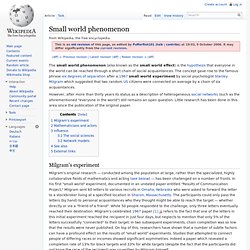
The concept gave rise to the famous phrase six degrees of separation after a 1967 small world experiment by social psychologist Stanley Milgram which suggested that two random US citizens were connected on average by a chain of six acquaintances. However, after more than thirty years its status as a description of heterogeneous social networks (such as the aforementioned "everyone in the world") still remains an open question.
Little research has been done in this area since the publication of the original paper. From World-Wide Web to Super-Brain. How the Internet is Shaping Our "Global Brain" - Tiffany Shlain. By Tiffany Shlain | 7:00 AM November 14, 2012.

How the Web Became Our ‘External Brain,’ and What It Means for Our Kids. Recently, my two-year-old nephew Benjamin came across a copy of Vanity Fair abandoned on the floor.
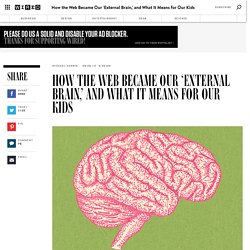
His eyes scanned the glossy cover, which shone less fiercely than the iPad he is used to but had a faint luster of its own. 100 Trillion Connections. 2045 Initiative. Pearltrees, le cerveau du web ? Pavel Risenberg. Nooblast Project inspired by the old days Noösphere concept.
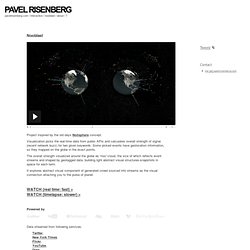
Visualization picks the real-time data from public APIs and calculates overall strength of signal (recent network buzz) for two given keywords. Some picked events have geolocation information, so they mapped on the globe in the exact points. The overall strength visualized around the globe as “noo”-cloud, the size of which reflects event streams and shaped by geotagged data, building light abstract visual structures-snapshots in space for each term. Towards a Global Brain. Heylighen F. (1997): "Towards a Global Brain.

Integrating Individuals into the World-Wide Electronic Network", in: Der Sinn der Sinne, Uta Brandes & Claudia Neumann (Ed.) TEDxCardiff - Google Consciousness - Maf Lewis, Rome Viharo. Google Consciousness. Google Consciousness. Google Consciousness Explained. By Rome Viharo for Google Consciousness Daniel Dennett’s model of consciousness in his landmark book "Consciousness Explained" deconstructs the ‘I’ experience down to ‘homunculi’ competing in the brain, each one a bit more stupid than the next until you get a ‘neuron’.
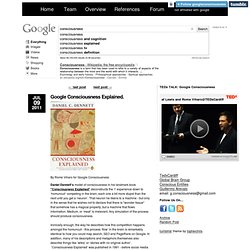
That neuron he likens to a machine - but only in the sense that he wishes not to declare that there is *wonder tissue* that somehow has a magical property, but a machine that flows information. Medium, or ‘meat’ is irrelevant. Any simulation of the process should produce consciousness. Ironically enough, the way he describes how this competition happens amongst the homunculi - this process ‘flow’ in the brain is remarkably identical to how you could map search, SEO and PageRank on Google. Simulating a Global Brain: using networks of international organizations, world problems, strategies, and values. 7 July 2001 using networks of international organizations, world problems, strategies, and values Anthony Judge, Nadia McLaren, Joel Fischer and Tomas Fulopp Paper for the First Global Brain Workshop: From Intelligent Networks to the Global Brain (3-5 July 2001, Vrije Universiteit Brussel, Brussels, Belgium ) [slide presentation as PDF] Abstract: The paper reports briefly on the ongoing process of systematic information collection and web presentation by the UIA of networks of over 30,000 international organizations, 56,000 perceived world problems, 32,000 advocated action strategies, and some 3,000 values -- resulting in a total of 800,000 hyperlinks.
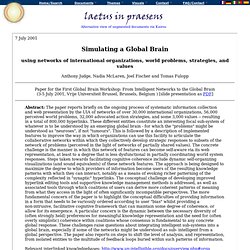
Is Twitter a Complex Adaptive System. I’ve seen a bunch of posts bubble up over the past few days that are really sparking my curiousity about what is really going on with Twitter, so I need to do a little brain dump.
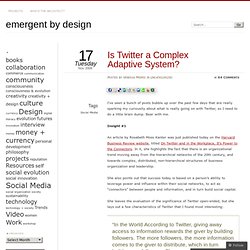
Bear with me. Twitter and the Global Brain. Is Twitter a Complex Adaptive System? Twitter is closer to emulate a Neural Network than Facebook. When we think of Twitter and the innovation behind it, the first thing we all think is 140. 140 characters is without a doubt an amazing innovation that Twitter introduced which makes communication flow faster, forces twitters to summarize a piece of news or information, or an idea or an opinion and allows followers to get information or an idea faster as well.
Also, after the introduction of url shorteners (tinyurl,com originally and many others later on such as bit.ly) an emergent property of Twitter came to life: the linked web. Any blog post or news article out there could be potentially linked multiple times in Twitter with quick summaries and opinions. Other emerging properties or elements in Twitter are:. Tags, early on twitters started using tags as a way to group events or themes together and follow them separately..
Curated content appeared more recently in an attempt to organize tweets in channels like mode. Synaptic Web. Stay updated about the Synaptic Web on Twitter via @SynapticWeb The Synaptic Web By Khris Loux, Eric Blantz, Chris Saad and you... The Internet is constantly evolving. DARPA SyNAPSE Program. Last updated: Jan 11, 2013 SyNAPSE is a DARPA-funded program to develop electronic neuromorphic machine technology that scales to biological levels. More simply stated, it is an attempt to build a new kind of computer with similar form and function to the mammalian brain. Such artificial brains would be used to build robots whose intelligence matches that of mice and cats. SyNAPSE is a backronym standing for Systems of Neuromorphic Adaptive Plastic Scalable Electronics. It started in 2008 and as of January 2013 has received $102.6 million in funding. The HyperWeb: it’s All About Connections. I recently came across this interesting graphic entitled Hierarchy of Visual Information. The author clearly states that it is a work in progress, just the genesis of an idea, a not-fully-formed thought.
In fact, he rightly points out that this–in general–is not a new concept at all and provides a link to a Google image search result showing many incarnations of the data-information-knowledge-wisdom concept. As I looked at his graphic, a different idea came to mind, a different interpretation of the concept in the context of the Web’s evolution. The hierarchical nature of the illustration made me think of the increasing complexity that comes with increasing connectivity.
It made me think of how hyperlinks (more precisely hypertext) preceded hyperdata. I realized that the hyper meme can be extended to the various evolutionary stages of the Web. The HyperWeb The HyperWeb is about increasing connectivity and the increasing complexity of those connections overtime. My Related Articles. A Neuroscientist’s Radical Theory of How Networks Become Conscious. It’s a question that’s perplexed philosophers for centuries and scientists for decades: Where does consciousness come from? We know it exists, at least in ourselves. But how it arises from chemistry and electricity in our brains is an unsolved mystery. We want to build a Planetary Nervous System. Interview with Dirk Helbing, Chair of Sociology, ETH Zürich, Switzerland Prof.Dr. Dirk Helbing, Chair of Sociology, in particular of Modeling and Simulation, at ETH Zürich, the Swiss Federal Institute of Technology Zurich (in German: Eidgenössische Technische Hochschule Zürich), Switzerland 1.
As Scientific Coordinator, you are one of the main driving forces behind FuturICT, one of Europe’s Future and Emerging Technologies (FET) Flagship Pilot research initiatives. Living Networks - The Book. Joël de Rosnay: «L’homme du futur sera relié au cerveau planétaire» Le XXIe siècle n’a pas commencé en l’an 2000, cette date parfaitement artificielle, mais il commence véritablement aujourd’hui, après une petite décennie de tâtonnements d’où sont en train d’émerger les grandes tendances de fond, les vraies lignes de force du siècle à venir.
Pour Joël de Rosnay, biologiste et docteur ès sciences, président de la Cité des sciences et de l’industrie à Paris, futurologue et auteur de plus d’une trentaine d’ouvrages, le monde actuel est en pleine effervescence et l’être humain à la veille d’une nouvelle aventure qui va transformer aussi bien sa conscience de soi que son rapport aux autres. Complex adaptive system. Autopoiesis & how hyper-connectivity is literally bringing the networks to life. Organic Computing. Système complexe adaptatif. Un article de Wikipédia, l'encyclopédie libre. Wild Computing.